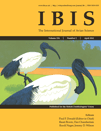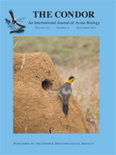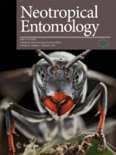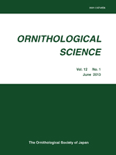
ORNITOLOGIA NEOTROPICAL
Scope & Guideline
Connecting researchers to elevate Neotropical ornithology.
Introduction
Aims and Scopes
- Avian Ecology and Behavior:
The journal emphasizes studies on the ecological roles and behaviors of birds, including feeding ecology, nesting habits, and social interactions, contributing to a deeper understanding of avian life in various ecosystems. - Conservation Biology:
A core aim is to address conservation issues, highlighting the threats faced by bird species and their habitats, and reporting on effective conservation strategies and policies. - Biodiversity and Distribution:
Research focusing on the distribution patterns of bird species, their habitat preferences, and the impact of environmental changes on avian biodiversity is a significant aspect of the journal. - Citizen Science Contributions:
The journal values contributions from citizen science, encouraging public involvement in bird monitoring and data collection, which enhances the understanding of avian populations and behaviors. - Morphological and Genetic Studies:
Studies examining the morphological traits and genetic diversity of bird species are frequently published, providing insights into evolutionary processes and species identification.
Trending and Emerging
- Climate Change Effects on Avifauna:
Research exploring the impacts of climate change on bird populations and their habitats has gained traction, emphasizing the vulnerability of certain species and the need for adaptive conservation strategies. - Behavioral Ecology:
There has been an increase in studies examining specific behavioral patterns, such as anting and mating displays, which enrich our understanding of avian life and its complexities. - Citizen Science and Public Engagement:
The integration of citizen science methodologies into research has risen, reflecting a trend towards collaborative data collection and community involvement in avian monitoring and conservation efforts. - Ecological Interactions and Food Webs:
Emerging research focuses on the interactions between birds and other species within ecosystems, including the role of birds in seed dispersal and their dietary preferences, showcasing the importance of avian roles in ecological networks. - Conservation Genomics:
The application of genomic techniques to conservation biology is becoming more prominent, providing insights into genetic diversity and population structure, which are critical for effective conservation planning.
Declining or Waning
- Traditional Taxonomy:
Research focused solely on traditional taxonomic classifications has decreased, likely due to the growing emphasis on molecular and genetic approaches to species identification and classification. - Urban Bird Studies:
Although urban ecology remains important, studies specifically addressing the impacts of urbanization on bird populations have become less frequent, possibly overshadowed by broader ecological and conservation topics. - Morphological Studies:
While still relevant, there appears to be a waning interest in purely morphological studies of birds without accompanying ecological or genetic analyses, as researchers increasingly seek integrative approaches. - Historical Avian Studies:
Papers focusing on historical accounts or older literature concerning avian species have diminished, as the journal shifts towards contemporary studies that address current ecological and conservation challenges.
Similar Journals

IBIS
Connecting research with conservation efforts.IBIS, published by WILEY, stands as a prestigious journal in the field of animal science, zoology, and ecology since its inception in 1859. With a focus on innovative research that informs the scientific community on ecological dynamics, behavioral studies, and conservation strategies, IBIS fills a critical niche for researchers, professionals, and students alike. The journal is recognized for its robust impact factor and commands a Q1 ranking in three key categories as of 2023, demonstrating its influence and reach within the global academic landscape, particularly in Animal Science, Ecology, Evolution, Behavior and Systematics, and Nature and Landscape Conservation. Although not an open-access publication, its rigorous peer-review process ensures high-quality contributions that advance knowledge in these vital areas. Through interdisciplinary collaboration and comprehensive coverage of cutting-edge topics, IBIS remains an essential resource for those striving to understand and protect our natural world.

Revista de Agricultura Neotropical
Connecting Researchers to the Heart of AgricultureRevista de Agricultura Neotropical, published by UNIV ESTADUAL MATO GROSSO SUL, serves as a pivotal platform for disseminating research in the fields of agronomy and crop science. Since its inception as an open-access journal in 2014, it has been dedicated to promoting innovative research and practical applications within the agricultural sector, specifically tailored to the challenges and dynamics of the tropical agriculture landscape in Brazil and beyond. Although currently positioned in the Q4 quartile of Scopus rankings, and with a modest agricultural science percentile, the journal actively encourages contributions that highlight sustainable agricultural practices, tropical crop management, and emerging technologies in farming. With its commitment to open access, the Revista de Agricultura Neotropical broadens the reach of critical knowledge, making it accessible to researchers, professionals, and students alike, thus fostering a collaborative environment for advancing agri-scientific initiatives.

Ornithological Applications
Exploring innovative solutions in ornithology.Ornithological Applications, published by Oxford University Press, is a premier academic journal dedicated to advancing the field of ornithology through innovative research and practical applications. With an impressive impact factor and recognized as a Q1 journal in both Animal Science and Zoology as well as Ecology, Evolution, Behavior and Systematics, it ranks among the top journals in its field, holding significance for researchers, professionals, and students alike. With a historical publication span from 1981 to the present, this journal has solidified its reputation for disseminating high-quality articles that explore avian biology, conservation, and management strategies. For those interested in open access publishing options, please check the title change details. As a vital resource, Ornithological Applications serves as a cornerstone for professionals looking to enhance their understanding of avian science and its critical applications in today's rapidly changing ecosystems.

NEOTROPICAL ENTOMOLOGY
Exploring Neotropical Biodiversity, One Insect at a TimeNEOTROPICAL ENTOMOLOGY, published by the Entomological Society of Brazil, is a leading journal in the field of Insect Science, recognized for its significant contributions to the understanding of entomological research within the Neotropical region. With an impact factor placing it in the Q2 category and ranked #52 out of 181 in the Scopus rankings for Agricultural and Biological Sciences, this journal provides a vital platform for both seasoned researchers and emerging scholars to publish their innovative findings. Covering a broad scope of topics related to entomology, NEOTROPICAL ENTOMOLOGY aims to highlight the unique biodiversity and ecological significance of insects, fostering further appreciation and study within this crucial area of life sciences. The journal is available in both print (ISSN: 1519-566X) and online (E-ISSN: 1678-8052), ensuring accessibility to a wide audience and enhancing the dissemination of knowledge. As it converges towards its 2024 volume, the journal remains committed to advancing the scientific understanding of insect life in the tropics, making it an essential resource for researchers, professionals, and students alike.

Neotropical Biology and Conservation
Innovating Conservation Strategies for Future GenerationsNeotropical Biology and Conservation, published by Pensoft Publishers, serves as a pivotal platform for researchers and professionals dedicated to the understanding and preservation of biodiversity in the Neotropical region. This Open Access journal, operational since 2006 and based in Brazil, invites contributions that delve into the complexities of ecology, evolution, and conservation strategies pertinent to the diverse ecosystems of South and Central America. With a commendable 2023 impact factor reflected in its Q3 rankings across multiple categories including Animal Science, Ecology, and Plant Science, it stands as a valuable resource for academics seeking to publish innovative findings and foster dialogue in these critical areas of study. The journal's commitment to open access ensures that knowledge is readily available to anyone interested in advancing the field of neotropical biology and conservation. Join the global conversation and contribute to the vital work of preserving our planet’s rich biological heritage through rigorous research published in this esteemed journal.

NOTORNIS
Fostering dialogue in the world of ornithology.NOTORNIS is a prestigious academic journal published by the Ornithological Society of New Zealand, dedicated to advancing the field of ornithology and contributing meaningful research related to avian species. With ISSN 0029-4470 and E-ISSN 1177-7680, this journal has been a vital resource for scholars since its inception in 1982, continuously fostering discourse within the scientific community, particularly in the realms of animal science and zoology. Though it currently holds a quartile ranking of Q4, with a Scopus rank of #250 out of 490 in its category, NOTORNIS occupies a unique niche in ornithological research, promoting studies that highlight the ecological and biological intricacies of birds. This journal is critical not only to researchers and professionals in zoology but also to students and educators aiming to engage with contemporary avian research. As New Zealand's leading ornithological publication, NOTORNIS underscores the importance of avifaunal studies in conserving biodiversity and understanding ecological dynamics.

JOURNAL OF ORNITHOLOGY
Advancing Knowledge in Bird ConservationJOURNAL OF ORNITHOLOGY, published by Springer Heidelberg, is a leading international journal dedicated to the study of birds and their conservation. With an ISSN of 2193-7192 and an E-ISSN of 2193-7206, this journal serves as a crucial platform for disseminating innovative research focused on avian biology, ecology, and behavior, making significant contributions to the fields of Agricultural and Biological Sciences and Animal Science and Zoology, where it holds a commendable rank of #156 out of 490 in Scopus. Established from 2004 and continuing through 2024, the journal strives not only to advance academic scholarship but also to inform practical conservation efforts globally. While currently not open access, it remains a vital resource for researchers, professionals, and students seeking high-quality studies and findings that influence the understanding and preservation of bird species. The journal's commitment to excellence in science highlights its importance in ornithological research, offering insights that are both profound and actionable.

ORNITHOLOGICAL SCIENCE
Connecting science and conservation for our feathered friends.ORNITHOLOGICAL SCIENCE, published by the Ornithological Society of Japan in collaboration with the University of Tokyo, stands as a pivotal platform for advancing knowledge in the field of ornithology. With a keen focus on avian biology and conservation, this esteemed journal is dedicated to publishing high-quality research, reviews, and technical notes that explore the intricacies of bird science. Although currently categorized within the Q4 quartile in Animal Science and Zoology, the journal aims to elevate its standings by fostering scholarly communication and impactful scientific discourse. This journal has been consistently publishing since its inception in 2002, with a brief hiatus before resuming its invaluable contributions to the scientific community in 2009. Despite the absence of specific open access options, the journal remains a crucial resource for researchers, professionals, and students seeking to expand their understanding of avian ecology and behavior. Through its comprehensive scope, ORNITHOLOGICAL SCIENCE reflects the increasing importance of ornithological studies in addressing global biodiversity issues and conservation challenges.

BIOTA NEOTROPICA
Championing Open Access to Ecological KnowledgeBIOTA NEOTROPICA is a prominent open access journal dedicated to advancing knowledge in the interdisciplinary field of ecology, evolution, behavior, and systematics. Published by REVISTA BIOTA NEOTROPICA since 2001, this Brazilian journal aims to provide a platform for high-quality research that fosters a deeper understanding of Neotropical biodiversity and its conservation. With an ISSN of 1676-0603 and an E-ISSN of 1676-0611, the journal has established its reputation within academic circles, ranking in the Q3 quartile for Ecology and achieving a respectable percentile of 57 in Scopus’s metrics. Operating from its headquarters in Campinas, SP, Brazil, BIOTA NEOTROPICA not only focuses on research dissemination but also encourages collaboration and exchange of ideas among scientists, students, and professionals in the field. The journal is particularly valuable for those looking to contribute to the understanding of ecological systems and promotes accessibility with its open access model.

MARINE ORNITHOLOGY
Unveiling the Wonders of Seabirds and Their HabitatsMarine Ornithology, published by the Pacific Seabird Group, is a vital resource in the field of animal science, zoology, and oceanography. With an ISSN of 1018-3337 and E-ISSN of 2074-1235, this journal has been a cornerstone for researchers and enthusiasts since its inception, actively contributing to the understanding of marine bird species and their ecosystems. Although it is currently not an open-access journal, it provides critical insights and findings that inform both academic research and practical conservation efforts. With its category quartiles positioned in Q3 for both Animal Science and Zoology, and Oceanography, Marine Ornithology occupies a significant, albeit competitive niche among scholarly publications. Researchers can benefit from its comprehensive coverage of marine avian studies, which is crucial for addressing the challenges these species face in changing oceanic environments. As the journal continues to evolve, with coverage from 1990 to 2024, it maintains an essential role in enriching our knowledge of marine biodiversity.